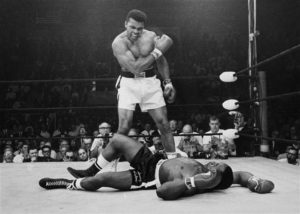THE REINVENTION: Changing For Greatness
April 20, 2024
BY: SERGIO F. BORGES
Remember cell phones in the 80s?, if not, think of the cell phones used in the films “The Wolf of Wall Street” or “Scarface.” Those phones looked like microwaves, now they are miniature computers. In essence, they became more efficient and effective…reinvented! What about individuals, or in this case, pugilists? Can professional boxers reinvent themselves? What does it mean for a boxer to be in their “prime” or “peak” Both “prime” and “peak” are as subjective as the sport itself. Can a boxer, who is considered a legend, reinvent himself to accommodate the current phase of his boxing limitations? This anomaly has occurred several times in the boxing world. So, how did they do it? Let’s examine and analyze two legends One old-school and one new-school, who accomplished this rare feat!

The first fighter that comes to mind, “The Greatest” Muhammad Ali! Ali won the gold medal at the 1960 Summer Olympics in Rome at the age of 18. Ali then commenced his professional career that fall. As I watch video highlights of his bouts with Archie Moore (1962), Sonny Liston (1964 and 1965), Floyd Patterson (1965), and Cleveland Williams (1966), I notice that Ali’s “out-box” style seemed perfect, but with flaws? His incredible footwork! To this day, I consider Ali’s legs and foot work, ahead of it’s time during the 60s, to be second to none. With blazing hand speed and unorthodox defense, he would pull back with both hands dropped and created a synergy that the boxing world labeled, “Lean-back style.” From March of 1967 through October of 1970, the New York State Athletic Commission suspended Ali’s boxing license and revoked his heavyweight belt. Ali was robbed from the bulk of his prime. In 1971, he suffered his first professional defeat via unanimous decision against Joe Frazier. 2 years later he loses a split decision versus Ken Norton. Fourteen years into his professional career, at the age of 32, he is facing the twenty-four-year old, undefeated, and heavyweight champion of the world, “BIG” George Foreman in “The Rumble in the Jungle.” Due to Ali’s age, diminishing skill-set and his opponent, Ali was given no chance to win the fight. Foreman, 40-0 (37), won the Heavyweight crown when he annihilated the undefeated Joe Frazier and destroyed Ken Norton. Fast forward to October 30, 1974 in Kinshasa, Zaire. I’m almost positive readers know what occurred, the impossible! Ali knocks out Foreman in the 8th round. How did he do it? We’ve all heard the saying, “Wisdom comes with age.” Analyzing the Ali of the 60’s and the Ali of the mid 70’s his legs, reflexes, speed and about every boxing attribute aged, but so did his ring IQ. Ali allowed the young Foreman to exhaust himself while Ali utilized the “rope-a-dope” strategy, The “rope-a-dope” is a strategy, coined by Ali, which consists of bobbing, weaving and using the looseness of the ropes to lean back with the idea that a heavy puncher, with heavy hands will wear himself out as he throws his heavy blows at what seems to be a wide opened target. When implemented correctly, the opponent begins to exhaust in the later rounds. Ali fought for eleven years after his suspension for refusing his induction into the U.S. Army during the Vietnam draft. His skill-set continued to diminish, but, like cream, his pedigree would “rise and shine” during the ring wars of the mid-seventies and eighties. Ali’s ring IQ and defense allowed him to be the first three-time heavyweight champion of the world. Ali retired in 1981. Due to the style Ali implemented and the damage he sustained during the latter part of his legendary career, Ali was diagnosed with Parkinson’s disease in 1984. Ali passed away on June 3, 2016… R.I.P. Champ!

Floyd “Pretty-Boy” Mayweather, Jr. was robbed of the Gold medal in the 1996 Summer Olympics in Atlanta where he lossed a disputed decision in the semi-finals leaving Mayweather having to settle for a bronze medal. Mayweather started his professional career in the fall of 1996 in the 130 lbs. super featherweight division. From October of 1996 through November of 2001, Mayweather was an unstoppable force. He possessed every attribute of a perfect boxer, literally and metaphorically. His reign at super featherweight was flawless and one of the greatest of all-time. From April 2002 through November 2003, Mayweather’s tenure in the 135 lbs. lightweight division was excellent but not as perfect as his reign at super featherweight. His first bout with Jose Luis Castillo was very controversial and a majority of the boxing world believed he lost, even though the three judges scored a unanimous decision for Mayweather. From May 2004 through June of 2005, Mayweather again stepped-up in weight and was fighting as a junior welterweight, 140 pounds. He annihilated everyone he faced at junior welterweight. Mayweather is nine years into his career and decides to jump weight class, again. His tenure as “Pretty-Boy” over 3 weight divisions was spectacular. His power, reflexes, speed, footwork, legs, defense, intuition and everything was flawless! “Pretty-Boy” 34-0 (23) moved up to the 147 pound welterweight division and after defeating Oscar De La Hoya at Jr. Middleweight (154 lbs.) he returned to the welterweight division and simultaneously reinvents himself. Changing his nickname to “Money.” You probably are saying, “It’s only seven pounds!” Those seven pounds, eleven years into his career were factors for Mayweather’s reinvention. The key factor was that Mayweather’s power did not carry up to welterweight with several hand injuries suffered while at the lower weight classes. Also, time takes its toll and every attribute of his skill-set aged. Mayweather would fight for twelve more years, with a few periods of inactivity along the way, “Money” received much criticism for his new method of fighting. How was he able to not lose during his twenty-six bouts as “Money”? Due to the factors previously stated, “Money” relied on his flawless defense, ring IQ, and ring generalship. Mayweather retired with a perfect record 50-0 (27). The president of CompuBox (Bob Cannobbio) stated, “Mayweather is the greatest boxer of all-time; his 46 percent connect rate, as opposed to an astonishing 16 percent punches landed by his opponent…statically, he is an outlier.”
When I step back, and analyze the “big picture,” I see attributes that I consider paramount for a fighter to “reinvent” themselves and continue a legendary career. First and foremost, a fighter must possess the natural God-given ability and athleticism. Pedigree, both Ali and Mayweather are Olympic medalists and Mayweather comes from a boxing bloodline (Floyd, Sr., Roger, and Jeff Mayweather). Ring IQ, I consider Ali to be one of the smartest fighters to ever step into a ring! Mayweather is right next to Ali. Mayweather’s ring IQ allowed him to win twenty six bouts in weight divisions (147 & 154) that his stature probably didn’t belong in, considering he often weighed less on fight night then he did at the weigh ins? Defense, Ali and Mayweather are defensive wizards, although Ali’s defense deteriorated late in his career in the ill-advised bouts that he took, he is still considered a defensive master in the rinng. Ring damage, the less damage sustained during your career, the easier it is to implement a style change that accommodates a fighter’s faded or compromised skills.
When boxers have past their prime, they try to rely on key fundamentals learned from the beginning of their boxing pedigree. When the prime of a legendary fighter passes them up, the ability to reinvent themselves is what many times puts a final stamp to their greatness, although also in many cases, the belief that they have reinvented themselves in the pursuit of one final heroic night often ends up with a great fighter’s record not being a numerical interpretation of what they accomplished or meant to the sport for so many years. They say power is the last attribute to go, I disagree… A fighter will die with his ring IQ.
About the Editor
Army Veteran and former Professional Boxer Simon Ruvalcaba started boxing at the age of ten and Had a 71 fight amateur career which featured a 139 lbs. 1998 8th U.S. Army Boxing Championship out of Camp Casey, Korea and a spot on the prestigious Army Boxing Team at Fort Hood, TX. After a journeyman pro career of 18 fights, which included sparring sessions with many champions and contenders including Julio Cesar Chavez and Pernell “Sweat Pea” Whitaker, Simon started writing and has contributed to many publications and websites including fighthype.com, pound4pound.com, Tahoe Daily Tribune (South Lake Tahoe, CA), Nevada Appeal (Carson City, NV). He has also been the Boxing Instructor for Ken Shamrock and The Lions Den and was MMA and Bareknuckle star Paige VanZant’s first boxing coach!
Born and Raised in South Lake Tahoe, California he now resides in Sun Valley, Nevada and spends as much time as possible with his Sons Gabriel and Oscar! Beyond boxing, Simon is an all around sports fanatic and is passionate about the teams that he roots for. Simon also works as a Sportsbook Supervisor for Caesars Sportsbook in Lake Tahoe.



